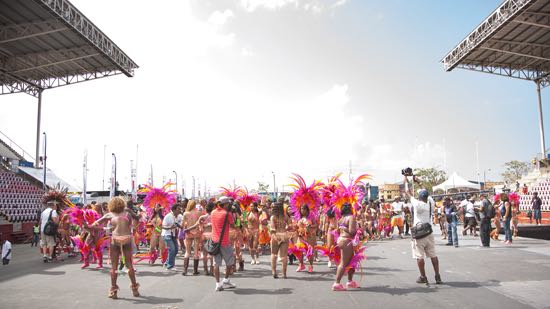Why I have nothing to say about your Facebook Carnival gallery
09/03/14 15:55 Filed in: Opinion

The Carnival Band Yuma was the first to cross the stage of the Socadrome on Carnival Tuesday. It was quickly met by a phalanx of photographers and videographers.
Photograph by Mark Lyndersay.
I have to tell you a story first. It’s an old photographer’s story, so be patient with my crusty old self.
It was the most perfect Carnival Tuesday.
I was photographing for the Guardian, shooting color transparency film for the paper’s souvenir and front pages and I’m pretty sure I remember both Harts and Barbarossa were in queue to cross the stage that evening.
These were bands full of beautiful people wearing skimpy, colorful costumes with a pent-up need to dance bawdily on the Savannah stage.
The sun was shining bright and strong and clear from the Western sky, the masqueraders were crossing the stage with verve and energy, spreading out to fill the temporary tarmac.
I had a good position stageside and a long lens at the ready, I began photographing with a broad smile.
As such things go, it was a duck shoot.
I remember looking to my left and down the stage to where another group of photographers stood, among them Mary and Noel Norton. Noel’s face was hidden behind his huge Nikon, Mary was scribbling away on a notepad with a bag of film at her side, ready to rearm her husband.
I swear, it has never been as good since.
So let’s acknowledge that day in the mid-1980’s as the apotheosis of my experience with Carnival photography. In the three decades that I’ve been photographing the event I can’t recall another moment that was as blessedly perfect as that one.
That doesn’t mean that there weren’t others, but they all had something in common that I treasure.
The nonpareil experience of bearing photographic witness to something so communal, so authentic, so absolutely, breathtakingly beautiful that all you can do is thank the divine graces that led you to that place at that time and put a camera in your hand.
This year, I didn’t even look at my photographs from Carnival Tuesday until four days later.
That’s some distance from rushing home after a ten-hour day photographing to heat up E-6 chemistry to run a batch of film so that you could see just what you’d got out of the day.
I haven’t even bothered to post the last two years of Carnival photography that I’ve done to my website. It’s not that the work isn’t any good; it’s simply that I feel no connection with it at all.
I’ve railed in the past about the way photography gets done in Carnival these days.
There is now a whole generation of young photographers who have come to expect that photographing the festival means inserting yourself into the mas itself, engaging in that curious back and forth between individual groups of masqueraders and clots of photographers that results in a record of Carnival that reflects nothing more than meaningless poses and a thunderous roar of accompanying shutter clicks.
I sift through the proud Facebook galleries of photographers whose work is otherwise smart, considered and thoughtful and see the same photo over and over again. The comments salute these images enthusiastically, adding a stamp of public endorsement to the blatantly fake, saluting pictures of joy manufactured in 1/125th of a second at f8, flash at - 1 stop, ETTL, and just as quickly dispensed with.
Finding an honest moment on Carnival Tuesday is now a task worthy of Diogenes, and I don’t think there’s a lamp left that’s bright enough to light the way.
I do have one photograph that I like from the event. A photo of a Tribe masquerader partying hard framed between two other players. It's a moment that feels like the type of thing that was once commonplace in the photography of the event.
But placed against the visual blizzard of images available of this year’s street party, all shot at close range with a hard flash on camera, it feels wrong, invasive, voyeuristic, perhaps, an unguarded view of pure pleasure.
So much of the photography of Carnival has become such a personal and specific thing, shared between a couple of masqueraders and a shooter. It’s no longer a performance captured while it’s addressed to an audience.
Unlike the Wee Gee clarity of today’s strobe-lit Carnival evidence record, this troubling image has both natural light and what seems for all the world like a natural moment inscribed into it. So why does it seem so very odd?
I leave it to you to consider and comment on that, if you wish.
Meanwhile, my interests in Carnival have drifted from the collection of moments that were once in such abundant supply to the quieter and less aggressively scrutinized creative engines of its creation.
Since 2007, I’ve devoted one installment of my Local Lives photo essay series to Carnival each year, beginning with my examination of the work of Anra Bobb, a Carnival queen contestant for many decades.
Local Lives is driven by curiosity, and my interest in Carnival’s execution remains undimmed even when I find so little of true interest at the core of the actual presentation on what was once its premium day, the culmination of the event, Carnival Tuesday.
There is so little left of what was once true Carnival documentation, the recording of the reality that was Trinidad and Tobago’s Carnival celebrations and so much of what is a continuously manufactured fiction, cock-up and pose galleries of staged merriment that it’s far easier to seek the truths of the festival offstage, where cameras rarely venture.
So at great length, this is why I don’t comment on your galleries. It’s not that I have nothing to say. It’s that I have too much in my head to dump on you.
And really, you don’t deserve it. You’re doing what you see other people doing and you’re probably doing it quite well.
I just know what it used to look like and I…well I just can’t.
Coda: Among the responses there have been mutterings that suggest that I don't know what popular event photography is like today.
Such comments are justified. I do not photograph for the popular party websites, nor is there any likelihood that I ever will.
I did, however, as a favour to Kevan Gibbs, a good friend of mine, cover three consecutive years of his Great Fete event in Tobago.
That coverage might seek to suggest other ways that popular parties might be represented in photographs. The expansive galleries related to that event are to be found here.
Related...
BitDepth#927: Lessons from the Socadrome
Guardian Editorial for March 10: More transparency in Carnival
BitDepth#926: Carnival's stuttering progress
Guardian Editorial for March 02: The Geography of Carnival
BitDepth#925: How I would fix Carnival
Guardian Editorial for February 26: Elitism or Entrepreneurship?
BitDepth#924: Carnival Copyright Redux
Suggestions to the NCC for accreditation improvements.
Narend Sooknarine's experience with the NCC accreditation team.
blog comments powered by Disqus
